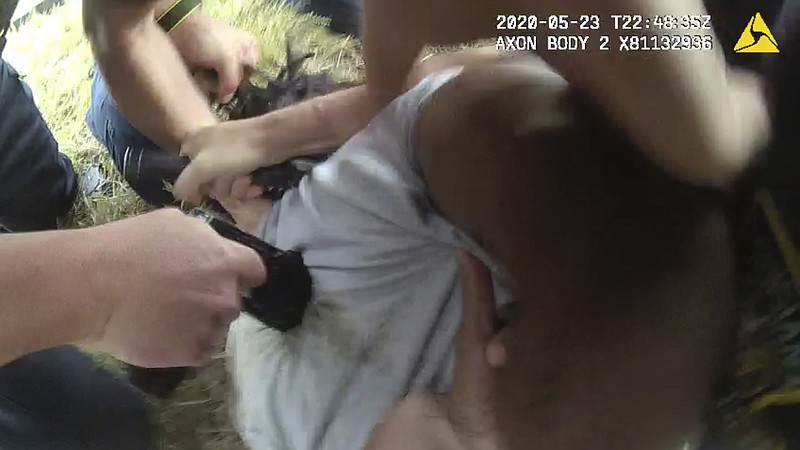BATON ROUGE, La. (AP) - The same Louisiana State Police unit whose troopers stunned, punched and dragged Ronald Greene on video during a deadly 2019 arrest is now under internal investigation by a secret panel over whether its officers are systematically targeting Black motorists for abuse.
The panel, whose existence was confirmed to the Associated Press by four people familiar with it, was set up in response to Greene's death as well as three other violent stops of Black men: one who was punched, stunned and hoisted to his feet by his hair braids in a body-camera video obtained by the AP, another who was beaten after he was handcuffed, and yet another who was slammed 18 times with a flashlight.
"Every time I told him to stop he'd hit me again," said Aaron Bowman, whose flashlight pummeling left him with three broken ribs, a broken jaw, a broken wrist and a gash to his head that required six staples to close. "I don't want to see this happen to nobody - not to my worst enemy."
The panel began working a few weeks ago to review thousands of body-camera videos over the past two years involving as many as a dozen white troopers, at least four of whom were involved in Greene's arrest.
The review is focused on Louisiana State Police Troop F, a 66-officer unit that patrols a sprawling territory in the northeastern part of the state and has become notorious in recent years for alleged acts of brutality that have resulted in felony charges against some of its troopers.
"You'd be nave to think it's limited to two or three instances. That's why you're seeing this audit, which is a substantial undertaking by any agency," said Rafael Goyeneche, a former prosecutor who is president of the Metropolitan Crime Commission, a New Orleans-based watchdog group. "They've got to identify these people and remove them from the organization."
Other than the federal civil rights investigation into Greene's death, the state police panel is the only known inquiry into possible systemic abuse and racism by its troopers.
Its seven members, drawn from officials from across the State Police, are not only scouring the videos for signs of excessive force, the people told the AP, but also examining whether troopers showed racist tendencies in their traffic stops and pursuits, and whether they mislabeled body-camera videos, turned off their cameras or used other means to hide evidence from internal investigators.
It's not clear if the panel has a deadline or if it plans to expand the inquiry to the eight other troops in the 1,200-officer state police.
The State Police did not immediately respond to a request for comment.
Secrecy has permeated the Greene case from the beginning.
Soon after Greene's May 10, 2019, death, troopers told his relatives he died in a crash following a chase on a rural road near Monroe. Later, State Police issued a one-page statement saying that troopers struggled with Greene during his arrest, and he died on the way to the hospital.
For more than two years, Louisiana officials from Democratic Gov. John Bel Edwards down rebuffed repeated requests to release the body-camera video of Greene's arrest.
However, that changed last month after the AP released footage it obtained showing troopers converging on Greene's car, repeatedly jolting the 49-year-old unarmed man with stun guns, putting him in a chokehold, striking him in the head and dragging him by his ankle shackles. Greene can be heard apologizing to the officers, telling them he is scared and moaning and gasping for air.
One 30-minute clip, which a supervisor denied having for two years, shows troopers ordering the heavyset Greene to remain facedown with his hands and feet restrained for more than nine minutes - a tactic use-of-force experts criticized as dangerous and likely to have restricted his breathing.
An autopsy report obtained by AP lists Greene's cause of death as "cocaine induced agitated delirium complicated by motor vehicle collision, physical struggle, inflicted head injury and restraint."
No troopers have been charged in Greene's arrest. Trooper Kory York, who was seen dragging Greene, was suspended without pay for 50 hours. Master Trooper Chris Hollingsworth, who was recorded on his body camera bragging he "beat the ever-living f--" out of Greene, was told he would be fired last year just hours before he died in single-vehicle car crash.
While none of the other beatings that prompted the broader review of Troop F resulted in deaths, all led to felony charges against some of the troopers involved. And like Greene, all the suspects were driving alone, were unarmed and didn't appear to resist after troopers closed in.
State police have not released body-camera video of any those cases, but AP obtained footage from the May 2020 arrest of Antonio Harris, who sped away from a traffic stop and led troopers through rural Richland Parish at speeds topping 150 mph before his car was finally stopped with a spike strip.

